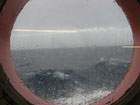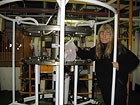

 | |||||||||||||||||
|
|
Journals 2007/2008Mark Goldner
November 24, 2007 60° 32' S 61° 24' W First of all, to put everyone's mind at ease, we did not witness the ship accident you may have heard about on Thursday. Apparently a small cruise ship (the Explorer) hit some ice and took on water. Thanks to ships nearby, all the passengers were taken off safely and no one was hurt. We had been very close to that area just a few hours prior to the accident. The ship's crew heard the distress call, but we were pretty far away by then, and other ships were in the area. We've been heading North since Thursday at a much slower pace than the scientists would like, due to very heavy seas. The plan is to visit each site where a CPIES has been deployed, to communicate with the CPIES to make sure it's functioning properly, and then to send down a "CTD cast" at that site to help calibrate the data from the CPIES. Unfortunately, if the seas are too rough, there's a serious risk of damaging the CTD equipment. So we've done a lot of waiting in the area until the seas get calmer. Last night we probably were experiencing 15-20 foot seas; today the seas are a bit calmer but not by much.
This afternoon the scientists finally decided to modify the CTD apparatus so they could send down a more limited package in order to proceed. At some point they'll be worried about running out of time. We need to get back to Punta Arenas by December 7, and each CTD cast takes several hours to run.
The rough seas have not been that easy on me. I've been feeling some low-level seasickness at times, which I've been able to keep at bay with a steady trickle of Dramamine. The pace of activity has definitely slowed down on board the ship. The CTD cast itself takes fewer people to run, and since we've been waiting around between CTD's to see if the seas calm down, there's just a whole lot more down time. In addition to getting to know people on the ship, I've had time for a few games of scrabble, chess and cribbage. We've also been plugging our way through the NY Times crossword puzzle; we get a limited version of the NY Times every day with selected stories and, of course, the puzzle. Life gets interesting (and we all get punchy) when you spend so much time on board a ship with the same people day in and day out. For example, at mealtimes this week we've been studying the "cooking cycle" on our ship. On Thanksgiving, for dinner, the cooks prepared an excellent meal, complete with Turkey, stuffing, barbecued chicken, etc. We also, however, encountered a "soup" that was unlike anything I've ever tasted. "Bad" is not quite the word to describe it. It has taken a group of brilliant scientists to figure out the true nature of the soup. At dinner, the world-renowned oceanographer, Dr. Randy Watts, began the discussion by encouraging us to use our powers of observation. "Taste it," he enthusiastically encouraged us, "I can't figure it out. It tastes like pumpkin, or carrots... or Drambuie." With that, each of us reluctantly agreed to participate in this scientific endeavor. My own hypothesis holds that there is a sort of "cycle" with some foods in the kitchen, and that this particular soup was part of a sort of leftovers- soup cycle. Here's the evidence to support my hypothesis: For three nights in a row prior to Thanksgiving, we were served a dish of cooked carrots and peas. By the night before Thanksgiving, the peas and carrots were getting pretty soft; I detected a strong hint of carrot in the soup. In fact, the soup was a sort of cross between an overly sweet pumpkin pie mix, pureed peas, and candied yams, all complete with a strange alcohol after taste. Clearly a lot of pureed leftovers could be hidden in such a concoction. Erran Sousa, one of the URI engineers, has his own corollary to this idea - perhaps leftover soup sometimes ends up in the cake? More tests remain to be done. Another exciting development in the "cooking cycle" is the strange aftertaste in the butter cookies.
(I should be careful - the food on the ship remains excellent! I am truly grateful for the tremendous effort and skill of the cooks on board.) Another fun experiment for today was seeing how far over I'd have to lean when the ship took a really bad roll. The picture doesn't really do justice to the phenomenon, but realize that I was actually standing up straight (the camera was moving with the ship).
Finally, tonight we begin our high pressure experiments. My 7th grade classes decorated some Styrofoam cups and some ping-pong balls. We have attached a mesh bag with some of those items to the next CTD cast, which will be testing water down to around 4,000 meter of depth (over 12,000 feet!). We are all eagerly awaiting what will happen to those objects when subjected to that kind of pressure. Also, my daughter Leah and her friend Peyton were interested in knowing what would happen to a Barbie doll at the bottom of the ocean. So, tonight, around 10 pm local time, Barbie will be making her first trip to the bottom of the ocean...!
|
||||||||||||||||




